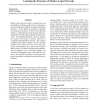Free Online Productivity Tools
i2Speak
i2Symbol
i2OCR
iTex2Img
iWeb2Print
iWeb2Shot
i2Type
iPdf2Split
iPdf2Merge
i2Bopomofo
i2Arabic
i2Style
i2Image
i2PDF
iLatex2Rtf
Sci2ools
ICML
2005
IEEE
2005
IEEE
Learning the structure of Markov logic networks
Markov logic networks (MLNs) combine logic and probability by attaching weights to first-order clauses, and viewing these as templates for features of Markov networks. In this paper we develop an algorithm for learning the structure of MLNs from relational databases, combining ideas from inductive logic programming (ILP) and feature induction in Markov networks. The algorithm performs a beam or shortestfirst search of the space of clauses, guided by a weighted pseudo-likelihood measure. This requires computing the optimal weights for each candidate structure, but we show how this can be done efficiently. The algorithm can be used to learn an MLN from scratch, or to refine an existing knowledge base. We have applied it in two real-world domains, and found that it outperforms using off-the-shelf ILP systems to learn the MLN structure, as well as pure ILP, purely probabilistic and purely knowledge-based approaches.
ICML 2005 | Machine Learning | Markov Logic Networks | Markov Networks | Off-the-shelf Ilp Systems |
| Added | 17 Nov 2009 |
| Updated | 17 Nov 2009 |
| Type | Conference |
| Year | 2005 |
| Where | ICML |
| Authors | Stanley Kok, Pedro Domingos |
Comments (0)

